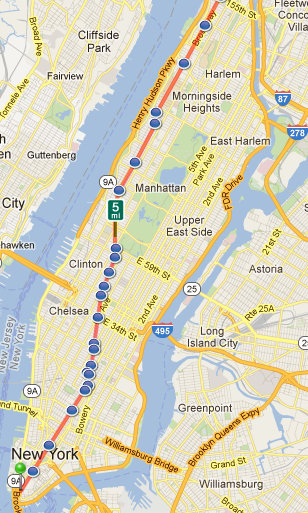In today’s hectic lifestyle most of us run around keeping our eyes forward making a direct beeline for our destination. Sometimes to avoid catching people’s eyes we even look down at the gum and cigarette encrusted ground. In doing so we miss a lot of what happens around us, and more importantly what is above us. Taking one of the busiest and most popular streets of New York City, I want to show you a glimpse of what you haven’t seen on your daily walks, although they’ve always been staring down at you.
Broadway. Famous for it’s glittering lights, shows and attractions, and one of the main tourist hubs of the city especially around Times Square. The street is in fact the oldest thoroughfare in the city spanning almost the entire Island of Manhattan. Its origins derive from the original New Amsterdam settlement for which it was known as the ‘Broad Way’ or Breede Weg from the original Dutch. Today the avenue cuts through the various districts of Manhattan resulting in a constant change of atmosphere and architecture as you walk along, but what most people are probably missing out on is the architecture above. Walking with nose up and eyes to the sky I am walking up Broadway watching the change of architecture above.
In Part I of this series, we’ll look at Broadway from the very southern tip to Canal Street. This section offers strong contrasts–from the high rises of the financial district to the smaller, but not less ornamented, buildings of Chinatown and Little Italy.
 26 Broadway-designed by Carrère and Hastings with Shreve, Lamb and Blake
26 Broadway-designed by Carrère and Hastings with Shreve, Lamb and Blake
Formerly the tallest building at the tip of Manhattan (and once used as a lighthouse for ships), 26 Broadway, the Standard Oil Building, was one of the first buildings to use setbacks as defined in the zoning code. The building’s ‘Mausoleum of Halicarnassus’ inspired tower dominates the beginning of Broadway.
 The ‘Medici Balls’ on the Frieze of the building fit in with the financial aspect of the area
The ‘Medici Balls’ on the Frieze of the building fit in with the financial aspect of the area
The Art Deco building at 29 Broadway and its neighbor’s façade were encrusted with beautiful little art deco decorations which caught my eye:
 29 Broadway designed by Sloan & Robertson
29 Broadway designed by Sloan & Robertson
The American Express building at 65 Broadway was built in the Neo-classical style. The soaring archway recalls a triumphal arch, befitting the financial setting:
 The American Express Building at 65 Broadway
The American Express Building at 65 Broadway
The Irving Trust Company Building, at 1 Wall Street (corner of Broadway and Wall Street) was designed by Ralph Walker. With the building’s soaring limestone facade, although not ornate like some of the surrounding buildings, the sleek undulating wall draws the eyes upwards to the soaring peak of the building putting an emphasis on its height and dominance in the area:
 The Building from its prime spot on the corner of Wall Street and Broadway
The Building from its prime spot on the corner of Wall Street and Broadway
Encrusted with Classical inspired decorations of columns and sculptures, the heavily encrusted facade of 100 Broadway contrasts with the sleek, soaring architecture of the nearby Irving Building, but all the details make for an interesting stop:
The Neo-Gothic style architecture at 111 Broadway looms over passers by with the gargoyles and faces set into the facade watching passers by:
 The Little Gargoyle and Heads watching those entering into the Trinity Building at 111 Broadway-Francis H. Kimball and Beyer, Blinder, Belle Architects & Planners PLC
The Little Gargoyle and Heads watching those entering into the Trinity Building at 111 Broadway-Francis H. Kimball and Beyer, Blinder, Belle Architects & Planners PLC
On the intersection of Cortlandt and Broadway, the roof of this building stood out because it was a pitched roof amidst all the high-rises. The building stood out with its projecting windows:
The ordered rows of Ionic Columns on the neo-classical façade at 195 Broadway were so visually organized one can’t help but look at it:
 195 Broadway-William Welles Bosworth
195 Broadway-William Welles Bosworth
Although not actually on Broadway, New York by Gehry can be viewed from Broadway across City Hall Park:
Another soaring neo-Gothic building towering over Broadway, the so-called ‘Cathedral of Commerce’ is a hybrid between a skyscraper and a Gothic building:
 The Woolworth Building at 233 Broadway-Cass Gilbert
The Woolworth Building at 233 Broadway-Cass Gilbert
At 277 Broadway, more faces and animal heads peer down on passers by from the top of the building:
The Rustication on the bottom and the top of the building at 305 Broadway are reminiscent of the Medici Palace in Florence, bringing a bit of Italian Renaissance and banking power to the Big Apple:
As the road continues past the financial district and more towards Chinatown, the building may get smaller but that doesn’t mean they are any less ornate:
The still ornamented small facade of 359 Broadway:
The pedimented windows, each different from the one before, create an interesting facade for the building, inviting the passer by to look up.
 Between Waller St. and White St.
Between Waller St. and White St.
The high arched windows divided by colonnettes made a nice end to the first stretch of Broadway mixing architecture which seemed to soar (like those of the financial distrcit) onto the small buildings of Chinatown to come…
Stay tuned for the next article in the series, “Don’t Forget to Look Up”!
















